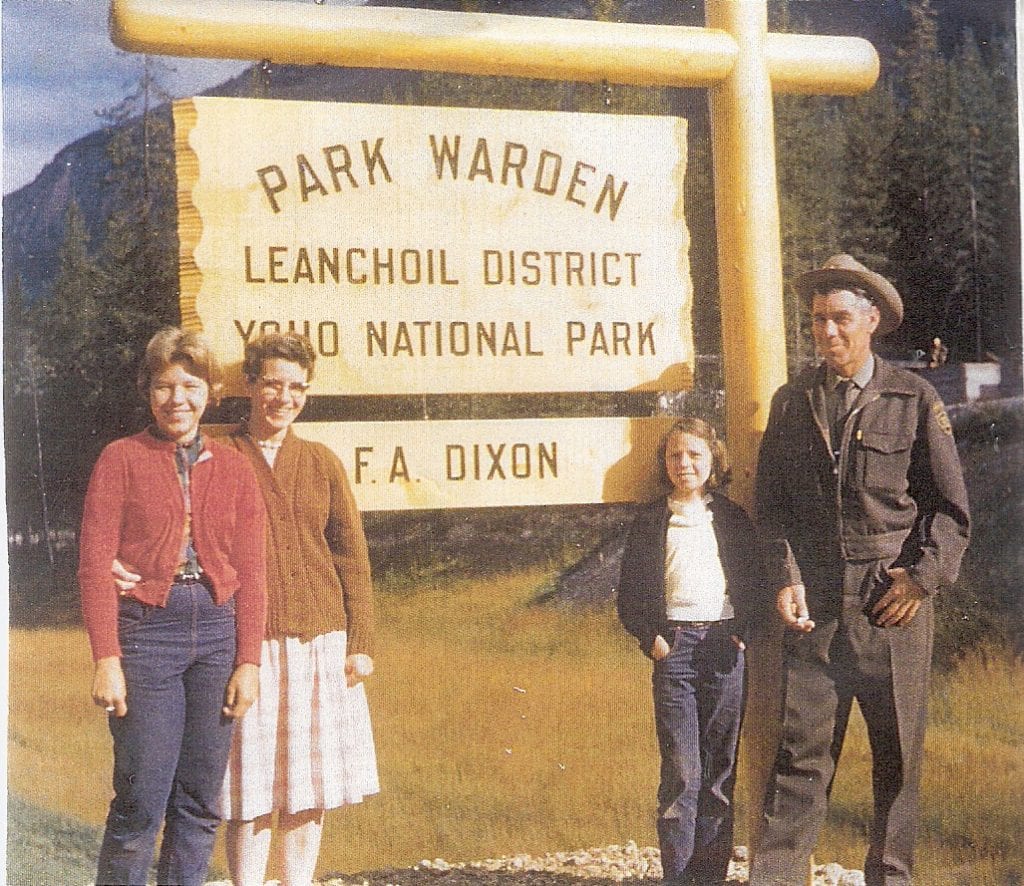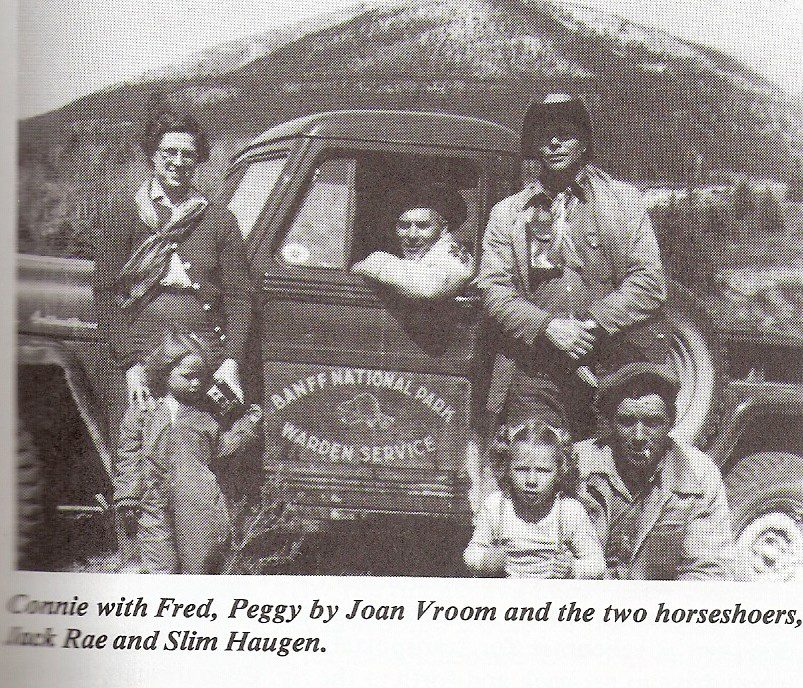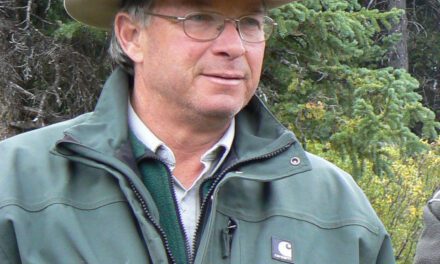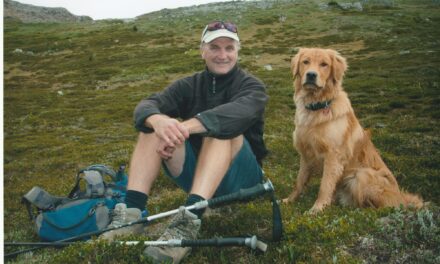Thank you to the Whyte Museum of the Canadian Rockies for granting permission to the Park Warden Service Alumni to post this interview on our website
Park Warden Alumni Society of Alberta
Oral History Project – Winter 2012
Interview with Ann Dixon and Her Daughters Peggy and Connie
May 11, 2012. Pincher Creek, Alberta
Interviewed by Rod Wallace whose wife Sharon was in attendance
The interview was transcribed by Christine Crilley-Everts

The Dixon Family Yoho National Park 1964
Connie, Ann, Peggy and Fred
Photo courtesy of Rod Wallace
Ann was married to warden Fred Dixon. She is the author of Silence Partners: Wives of National Park Wardens.
Place and Date of Birth: Ann Dixon was born in 1926 in Raymond, Alberta. Fred was born July 19, 1920 in Keoma, Alberta.
Occupations: After finishing school Ann attended Olds College. She then worked at Saint Michael’s hospital as a lab assistant. Once she married her husband Fred and moved to the Ya Ha Tinda, Ann cooked for the different work crews, and recorded the weather daily for the park, in addition to taking care of her family and helping with all the jobs associated with ranch life. When Fred was transferred to Yoho National Park, Ann worked seasonally in the Visitor Information Bureau in Field. She is the creator of the Park Warden History quilt and the author of Silent Partners: Wives of National Park Wardens, a book which documents and honors the invaluable contributions of the women married to national park wardens.
Fred began working as a ranch hand at the Ya Ha Tinda in the early 1950s. He then became the foreman of the ranch. By the early 1960s he was working as a park warden, first as a grade one warden in the Saskatchewan River district of Banff National Park, then as a grade two warden in Yoho National Park. After a number of years in Yoho, Fred was transferred to Riding Mountain, where he worked for four years. Fred ended his warden career in Elk Island National Park when he retired in 1980 after 27 years of service. He is well known and respected for his love of horses and special way with animals.
Additional Information: Peggy Dixon-McRae is an artist who lives with her family on a cattle ranch in southern Alberta. Her sister Connie Laitinen has recently moved to Kitimat, British Columbia where she works as a mediator and negotiator with First Nations communities. Both Peggy and Connie have followed in their mother’s creative pursuits, Peggy with drawing and fabric art and Connie with bead work.
(0:04) Rod – Ann Dixon was born in Raymond, Alberta in the family home in 1926. Her father owned an irrigation farm and he also rode the irrigation ditches (At that time people would steal water at night by redirecting it from the canal with a tarp. A ditch rider was hired to patrol for maintenance and water theft). Ann moved to Lethbridge when she was approximately 12 years old. She went to the McNalley School south of Lethbridge for grades seven, eight, nine and ten. Your mother worked on the farm with your dad right?
(0:49) Ann – And raised kids.
(0:54) Peggy – She raised five kids.
(0:58) Ann – She was from Ireland.
(1:09) Rod – Where and when did you meet Fred…Or actually maybe we could start with what you did before you met Fred?
(1:38) Ann – I went to school for a couple of years in Olds, Alberta, the Olds School of Agriculture. Then when I came back from there I got a job working at Saint Michaels Hospital as a tray girl. I worked my way up from there to an assistant in the laboratory downstairs in the hospital. They wanted me to take my training for lab work, but I was having too much fun!
(2:24) Rod – You can’t tell us any of those stories!
(2:25) Ann – I can’t, no! (Laughter)
(2:34) Peggy – Not in front of her kids!
(2:37) Ann – No! Where did I meet Fred? He was a blind date that my brother got together in Lethbridge. They both drove gravel trucks for construction.
(2:57) Ann – Yeah, a blind date! They said that I had two choices. There was Fred and this other guy. So I kind of liked Fred, he looked nice. “I’ll go with him!”
(3:14) Rod – Was this in Olds?
(3:15) Ann – No, this was in Lethbridge.
(3:19) Connie- And you had to have a chaperon. Remember, they sent your brother with you all the time when you dated?
(3:32) Peggy – In those days, the only girl in the family had to have a chaperone when she went on a date!
(3:40) Ann – He was a wonderful guy.
(3:43) Rod – He sure was! So how did Fred come to work at the Ya Ha Tinda? It is written in your book Silent Partners page 13.
(4:03) Ann – (Reading from her book) “Our first encounter with national parks was in the early 1950s when my husband Fred, hired on as a ranch hand at Ya Ha Tinda. He was a one man crew sent out to help the foreman Lloyd Waikle with breaking, training and caring for some 200 head of horses used by park wardens in western national parks.” And he liked it.
(4:42) Rod – What do you think he liked best about working at the Ya Ha Tinda? The location perhaps?
(4:49) Ann – No, the horses. He just loved horses, especially the little colts.
(5:01) Ann – I have to tell you about the brand. The horse brand (the bighorn sheep head) was the only brand recorded at that time in Alberta, a one iron symbol brand. It was recorded at the Settler Brand Registry office on October 24, 1913. It is one of the few single symbol brands remaining in use in Alberta today. (Silent Partners, page 202.)

Bighorn Sheep Brand (Photo courtesy of Marie Nylund)
(5:36) Rod – On the left shoulder.
(5:37) Ann – On the front left shoulder, yep. So Lloyd and Fred, mostly Fred used to brand the colts when they were big enough to be branded.
(5:59) Rod – And you mentioned Slim Haugen and Glen Fagan who worked with Fred at the ranch.
(6:08) Ann – Slim Haugen, he was the fellow who came out with the horse shoers every spring. Then of course, he was part of the crew who rode to take the horses back into Banff. That was a two day trip.

Photo from Ann Dixon’s book Silent Partners: Wives of National Park Wardens
(6:32) Rod – Down the Cascade fire road?
(6:33) Ann – Yes, that was the end of the trip, but I just don’t remember where they stayed overnight the first night.
(6:44) Rod – Scotch Camp.
(6:66) Ann – Someplace where they could put the horses in anyway, in the corrals. It was always pretty exciting for those guys, especially the young fellows that just hired on you know. They really enjoyed it. That morning before they left I always made breakfast. They always ate at the ranch house…I made a huge pile of pancakes and this young kid I forget what his name was. He was in the riding bunch and I don’t know how many pancakes he ate. He must have ate a barrel full! He sat on the floor in the kitchen and just wallowed around, he was so full!

Photo from Ann Dixon’s book Silent Partners: Wives of National Park Wardens
(7:50) Rod – He could hardly get on his horse I bet.
(7:51) Ann – He could hardly get up off the floor!
(7:55) Peggy – You always made really good pancakes. That round table that we ate off, I have it. So it is kind of neat. We asked if they wanted it for historical value or anything and nobody wanted it, it wasn’t in very good shape. You could always put one more person around it.
(8:21) Ann – Yep!
(8:22) Rod – Was the present foreman’s house (at the Ya Ha Tinda ranch) built at that time or later? No it was later. You stayed in the upper house.
(8:32) Ann – We stayed in the main building, a log house. (It is gone now). Lloyd who was the foreman at that time, he stayed in the bunkhouse with his cat who we called Yellow Tom. But when we were there, Yellow Tom seemed to take a liking to Connie. So he became her cat. But he always stayed with Lloyd in the bunkhouse at night.

Ya Ha Tinda Old Log House, Pump House and Log Barn – Photo Courtesy of Ann Dixon

Close Up of Ya Ha Tinda Log House – Photo Courtesy of Ann Dixon



